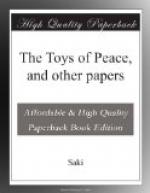THE TOYS OF PEACE
“Harvey,” said Eleanor Bope, handing her brother a cutting from a London morning paper of the 19th of March, “just read this about children’s toys, please; it exactly carries out some of our ideas about influence and upbringing.”
“In the view of the National Peace Council,” ran the extract, “there are grave objections to presenting our boys with regiments of fighting men, batteries of guns, and squadrons of ‘Dreadnoughts.’ Boys, the Council admits, naturally love fighting and all the panoply of war . . . but that is no reason for encouraging, and perhaps giving permanent form to, their primitive instincts. At the Children’s Welfare Exhibition, which opens at Olympia in three weeks’ time, the Peace Council will make an alternative suggestion to parents in the shape of an exhibition of ’peace toys.’ In front of a specially-painted representation of the Peace Palace at The Hague will be grouped, not miniature soldiers but miniature civilians, not guns but ploughs and the tools of industry . . . It is hoped that manufacturers may take a hint from the exhibit, which will bear fruit in the toy shops.”
“The idea is certainly an interesting and very well-meaning one,” said Harvey; “whether it would succeed well in practice—”
“We must try,” interrupted his sister; “you are coming down to us at Easter, and you always bring the boys some toys, so that will be an excellent opportunity for you to inaugurate the new experiment. Go about in the shops and buy any little toys and models that have special bearing on civilian life in its more peaceful aspects. Of course you must explain the toys to the children and interest them in the new idea. I regret to say that the ‘Siege of Adrianople’ toy, that their Aunt Susan sent them, didn’t need any explanation; they knew all the uniforms and flags, and even the names of the respective commanders, and when I heard them one day using what seemed to be the most objectionable language they said it was Bulgarian words of command; of course it may have been, but at any rate I took the toy away from them. Now I shall expect your Easter gifts to give quite a new impulse and direction to the children’s minds; Eric is not eleven yet, and Bertie is only nine-and-a-half, so they are really at a most impressionable age.”
“There is primitive instinct to be taken into consideration, you know,” said Harvey doubtfully, “and hereditary tendencies as well. One of their great-uncles fought in the most intolerant fashion at Inkerman—he was specially mentioned in dispatches, I believe—and their great-grandfather smashed all his Whig neighbours’ hot houses when the great Reform Bill was passed. Still, as you say, they are at an impressionable age. I will do my best.”




